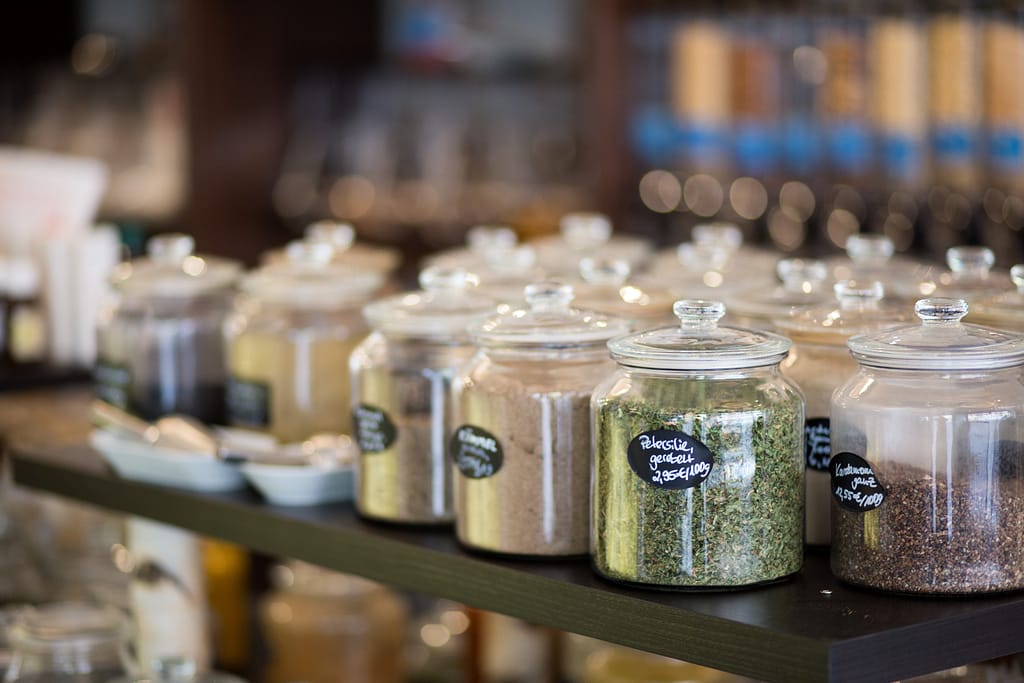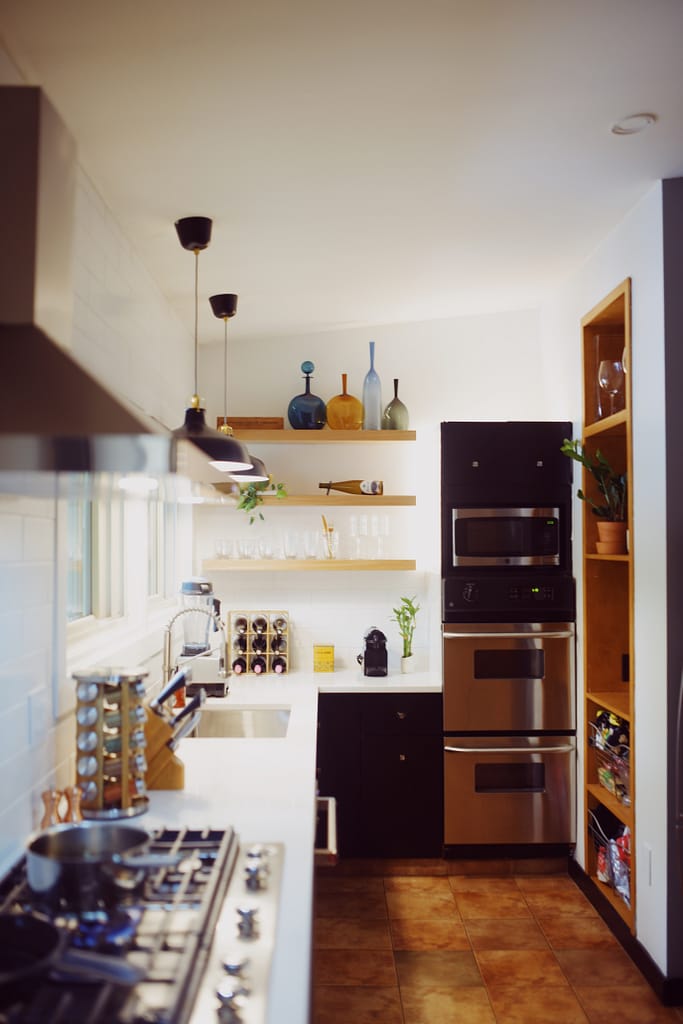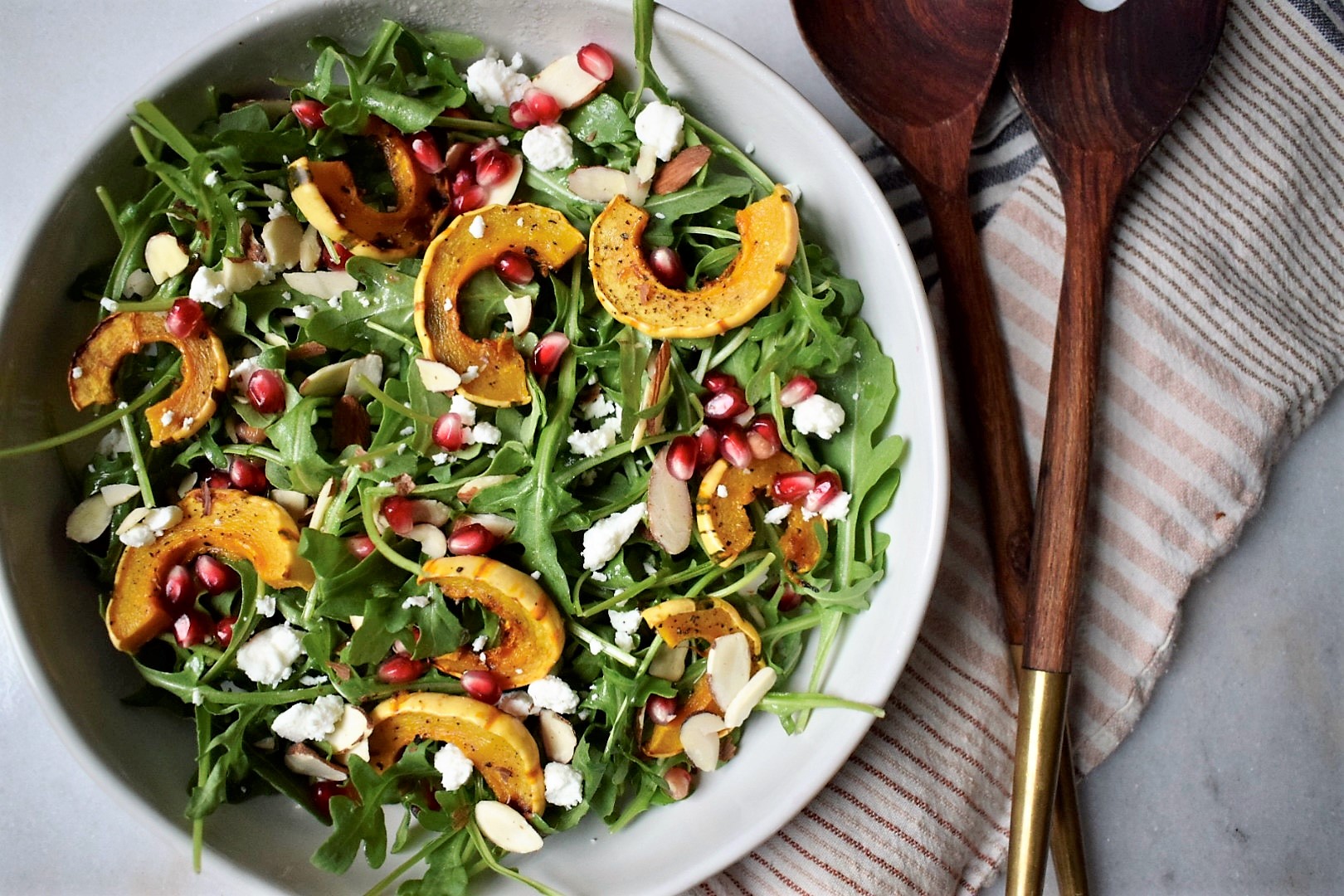This post contains affiliate links. See disclaimer for more info.
45 things to keep stocked for healthy dinners & clean eating
I’ve outlined why I think home cooking is so important below, but click here to jump straight to the 45 things I keep stocked for healthy dinners.
Every week I buy fresh produce and meat, but I’ll be honest… I don’t always shop with a plan for that week’s dinners. I like to see what’s fresh, what’s on sale, and what looks good at the store. That means I usually come up with some combinations while I’m shopping and wing it a bit during the week. I also keep most meals pretty straightforward (roast veggies, a protein, simple salad, etc.) and just try bring the best out of high quality ingredients.
I love a good recipe, but since I prioritize home cooking most nights, I don’t get carried away because I know that wouldn’t be sustainable. I did a lot of elaborate (long shopping list) recipes before having kids. Now, dinners at 8:30pm with a huge pile of dishes just aren’t in the cards!
These days, I’m able to improvise and make healthy, delicious meals without a lot of planning because I have a well-stocked kitchen. There’re several things I always have in my freezer as well as lots of spices, sauces, and condiments that build flavor, or allow me to do an Asian or Mexican spin on a meal.
I hope this makes home cooking and clean eating easier and less daunting for you!

Why cooking is your best bet for healthy dinners & clean eating
No one will dispute that healthy eating is a key pillar of feeling good and overall wellness. And I strongly believe home cooking is an important way to maximize the benefits of healthy eating and the very best way to have a clean, whole foods diet. I’m a proponent of home cooking as much as possible, and my goal is to help you make that easier – even if it’s just a couple nights a week to start.
What are the benefits of cooking?
What I don’t like about eating out and prepared foods:
- Even the salad bar at nice grocery stores and restaurants touting “locally sourced” use non-organic products, many of which are on the Dirty Dozen list of produce with the highest amounts of pesticide residue. Once in a while is fine, but it’s not what I want to consume everyday. Studies link the consumption of foods high in pesticide residue with increased rates of cancer and fertility issues. This New York Times article also notes the link between pesticides and other environmental toxins with the rise of Autism.
- Almost every restaurant and commercial kitchen uses cheap, refined, highly processed oils that I recommend avoiding (see my post on The Problem with Vegetable Oils). These are highly inflammatory and are known to damage the cells in our bodies. If you’re already convinced that it’s best to avoid processed foods, be very mindful about these oils. This is often what I don’t like about a lot of packaged “health” foods and it’s one reason the Paleo diet tends to boost people’s health.
- There’s a ton of “local” and “green” washing. Many restaurants do source from local or organic farms, but it’s often not exclusively what they serve. You have a better chance to know what you’re getting when you shop at a reputable grocery store or at a farmer’s market.
- To-go food is usually stored in plastic. Research suggests that all plastic leaches, but the disposable plastic that holds hot, acidic, or fatty foods are especially concerning and increase the amount that’s adsorbed into the food and ingested.
- Cooking at home is less expensive. You can buy the best quality ingredients and have a meal that costs substantially less than what you’d typically pay to go out or order in.
The secret to healthy dinners and clean eating: a well stocked kitchen
Now, how can home cooking be practical and not a constant headache of grocery shopping for every recipe? I believe the secret is having a well-stocked kitchen. Whipping up a healthy dinner on a busy night, improvising when you don’t have a solid plan, or testing out a recipe you come across on Pinterest is much easier if you have the right spices, condiments, and a few key items in your freezer.

Stocking-up for healthy dinners
Here’s a detailed list of what I keep stocked for healthy dinners. Each item is hyperlinked for easy shopping, and I’ve included links to recipes and info on how I use these items as well. Send me a message if you have any questions!
Note: I try to buy organic food as much as possible. I’ve added an asterisk (*) next to the items that I’d prioritize if you can’t buy all organic.
Oils & Acids
- Champagne vinegar* – my nightly salad dressing is made with this, EVOO, salt & pepper. I also use it in marinades for chicken and pork tenderloin.
- Unfiltered extra virgin olive oil – I use it for dressings and I drizzle it on steamed / grilled / roasted veggies (though I cook them in avocado oil, not evoo).
- Avocado oil – this is what I use for high-heat sautes, marinades, roast veggies, and salad dressing when I’m using Mexican or Asian flavors. It has a higher smoke point than EVOO, which is not great for high heat cooking.
- Rice vinegar* – a go-to seasoning for Asian cooking. I mix this with avocado oil and sesame oil for Asian-inspired salad dressings and sauces like this Carrot Ginger dressing.
- 100% Lemon juice (bottled) – delicious on almost any steamed / roasted vegetable and great for aiolis, dressings and marinades. (Or keep some fresh lemons on hand – they keep a while in the refrigerator).
-
100% Lime juice (bottled) – great to have on hand for Mexican cooking (guacamole, salad dressings) and skinny margaritas.
Sauces, Condiments & International Section
- 100% Avocado oil mayo – I love sauces and this is the base for a my “good on everything aioli” and an Asian dipping sauce I also make. I also use it to coat my salmon and keep it nice and moist.
- Tamari* – a go-to seasoning for Asian cooking. It’s very similar to soy sauce, but without the wheat (it’s GF). Note: not Paleo/Whole30 compliant.
- Coconut aminos – another go-to seasoning for Asian cooking. This is a good soy-free sub for tamari / soy sauce; note it has a slightly sweeter flavor.
- Fish sauce – also a go-to seasoning for Asian cooking. Sounds strange, but a few dashes add great flavor.
- Toasted sesame oil – also a go-to seasoning for Asian cooking. Just a dash adds nice, rich flavor.
- Salsa verde* – (1-2 jars) I like to have this on hand for Instant Pot Chicken Salsa Verde.
Jarred Vegetables
- Capers* – great for Italian and Mediterranean-inspired cooking. I love these with lemony braised chicken thighs.
- Pitted olives (2-3 jars) – also great with braised chicken thighs, my Moroccan Spiced Chicken with Lemons and Olives, and nice for a quick snack or app when you have people over.
- Diced or crushed tomatoes* (2-4 jars) – I like to have these on hand to make homemade pasta sauce and chili.
- Kimchi (refrigerated section)- adds flavor and probiotics to a meal with Asian flavors.
- Sauerkraut (refrigerated section) – I prefer plain or with seaweed and without caraway seeds. This adds acidity and probitics to almost any meal. I have a scoop on my salad every night, and love it with salmon.
Produce Section
Reminder, these are long shelf-life items to have on hand so that you can improvise. You’ll need fresh produce for your meals each week.
- Onions – they are incredibly nutritious and are are the base of many recipes. Lately I’m really enjoying sweet onions like in this recipe.
- Garlic* – also incredibly nutritious, and they add flavor to so many recipes.
- Sweet potatoes – they make for a delicious and crowd-pleasing side + lots of different ways to prepare (baked or roasted with avocado oil and curry powder*).
- Spaghetti squash* – they keep for a while and can be transformed into a quick and healthy meal (especially if you have an Instant Pot) with either pasta sauce, or vegetables and Asian flavors like this dish.
- Cabbage – this powerhouse cruciferous veggie is packed with nutrients and vitamin C and can last up to 2 months in the refrigerator. I use these to make slaw, stir fry, and sometimes stretch out a box of greens by adding a big bunch of shredded cabbage to our regular salads.
- Cherry tomatoes* – these last about 10 days in the refrigerator, so I usually get at least 2 pints. They go well in salads and add color (not to mention vitamin C and lycopene) to braised chicken thighs. I also like to toss a handful in with a sheet of roast veggies.
- Fresh ginger* – I use it in Asian dishes all the time and also make a digestive tea by grating a little and adding ~1/8 teaspoon of honey to some hot water. Ginger will keep in the refrigerator for about a month, but I like to store it in the freezer.
Meat & Dairy
- Natural chicken & spinach sausages* – these are a staple in our household. We make them for family dinners and they’re a go-to for our kids when we have a date night. I’ve seen even picky eaters gobble them up. They keep in the refrigerator for a few weeks and can also be frozen for a quick meal on short notice.
- Butter (pasture-raised / grass-fed)* – a definite kitchen staple. Sometimes I add it to my coffee, as a topping for baked sweet potatoes, with green beans, and in my pasta sauce.
- Bacon (sugar-free & pasture-raised) – a couple of slices can add great flavor and richness to soups, stir-fry, or roasted veggies like cauliflower, broccoli, and asparagus.
- Parmesan cheese (grass-fed)* – we don’t eat much dairy, but Parmesan is very low in lactose. We use it primarily as a seasoning / topping (e.g. on spaghetti squash pasta).
Freezer Section
- Frozen cauliflower rice (3-4 bags) – as a side, the base for Cauliflower Fried Rice, Cauliflower Mash, or for a soup.
- Cappello’s GF frozen pizzas – these contain dairy, but they’re gluten-free and are the only frozen pizzas I’ve found made with clean ingredients (including EVOO instead of canola or soy oil). Always good to have a few on hand for crazy days when I need a quick, easy dinner, or for our kids when we’re leaving them with a babysitter.
- Frozen spinach* (3-4 bags) – as long as you have frozen spinach, garlic and lemon juice, you can have a quick and super healthy side even if you’re out of fresh produce. I’ve also added this to frittatas and lots of other recipes to add some healthy greens.
- Frozen artichoke hearts – a great addition to braised chicken thighs, also so nutritious and easy.
- Frozen wild sockeye salmon – this comes in bags of individually packaged fillets; I make this for dinner about once a week. I usually thaw in the refrigerator for ~24 hrs in advance.
Spices & Seasonings
- Sea salt – I primarily use pink salt because it’s very pure and has trace minerals that regular salt does not. Redmond’s Real Salt is a great product. It’s from an ancient, pristine ocean in Utah. I add this to just about everything I cook.
- Peppercorns* – we also add fresh-cracked pepper to almost everything.
- Truffle finishing salt – a pinch goes a long way; it adds great flavor and richness to soups and all kinds of steamed and roasted veggies (cauliflower, potatoes, asparagus, etc.). It’s expensive, but can last well over a year.
- Spice blend* – my favorite is the Bragg 24 Seasoning blend. Love it on chicken and in this pork tenderloin / mushroom recipe.
- Cumin* – used in most Mexican-inspired recipes (guacamole, salads, slaw, chicken).
- Curry powder* – this is an easy way to add beneficial spices and flavor to roast sweet potatoes and cauliflower, and I use it in my curry chicken salad.
- Sage* – primary seasoning I use for roast lamb and lamb burgers.
- Chili powder* – Lots of recipes call for this and veggie-loaded chili is an easy and flavorful meal I make throughout the winter.
Miscellaneous
- Dark chocolate* (70%+ cacao)- I have a couple of squares for dessert most nights.
- Natural wine* – I enjoy wine with dinner almost every day, and I’m a fan of natural over conventional wine, which has lots of health benefits. I get mine from Dry Farm Wines. Unlike conventional wine, theirs are sugar free, low in sulfites, lower in alcohol and free of dozens of additives and pesticides.
- Sliced almonds – adds a healthy crunch to salads, a side of green beans, curry chicken salad, and pan-seared whitefish with some butter.
- Sprouted Quinoa – GF, grain-free, high in protein, and very quick to prepare. Dress it up with sliced almonds, cherry tomatoes, or diced vegetables (even frozen peas). Love it with Macro Plates. Use broth instead of water to add extra flavor.
I hope this helps you get stocked up for healthy dinners!
I’m planning to create some weekly meal plans that will help you make use of all these great ingredients and staples. Please drop me a note in the comments! Let me know if you have any thoughts or suggestions of other kitchen staples you can’t live without for healthy dinners!








